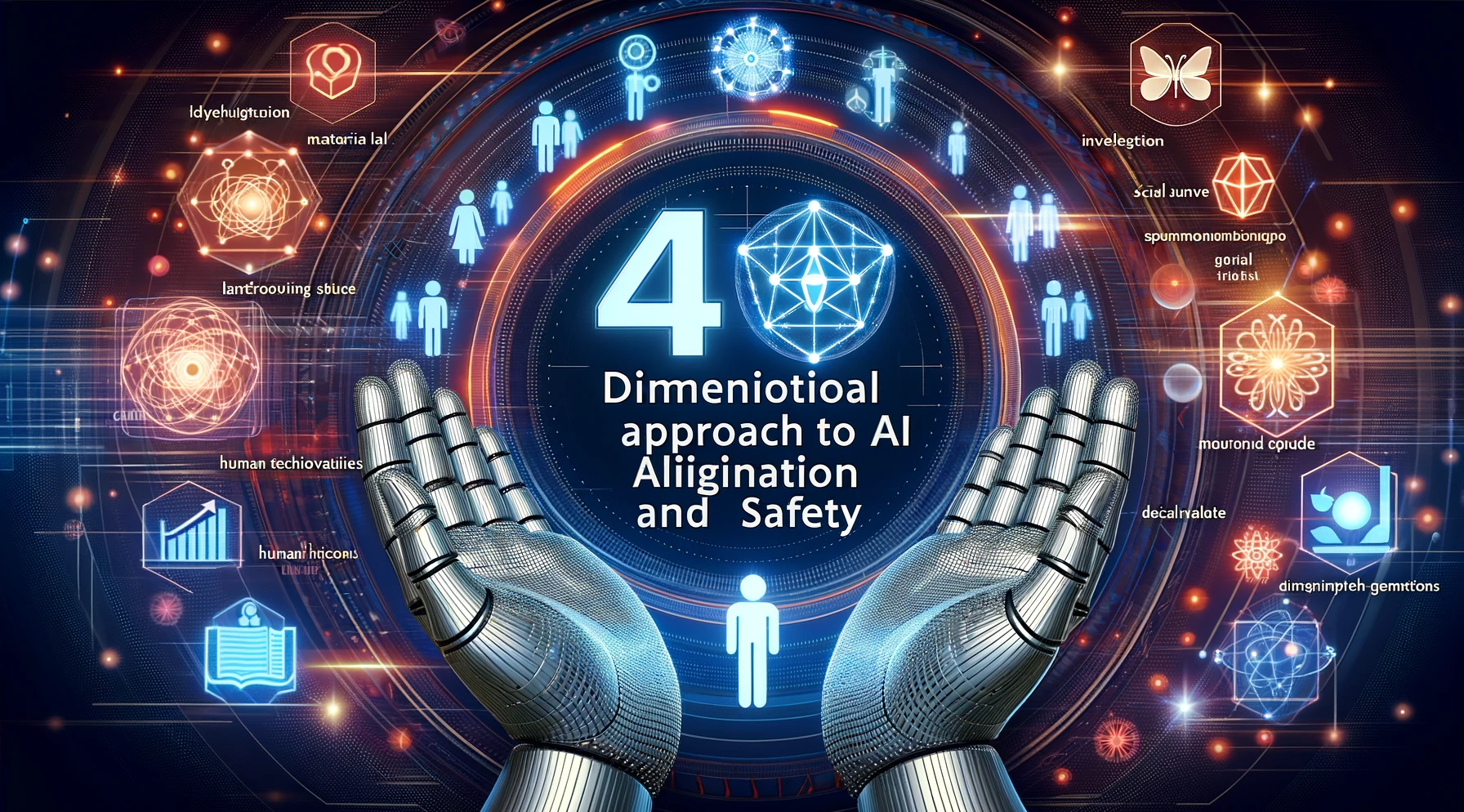|
The 4-Dimensional
Approach for Humans to Manage Highly
Intelligent AI Assistants
Dr. Alex Liu
with ASI Research
December 2023
Introduction
As artificial
intelligence (AI) assistants increasingly
surpass human intelligence in various
domains, their management by humans
introduces both unique challenges and
opportunities. The concept of
superalignment, or the pursuit of AI safety,
becomes paramount when dealing with these
superintelligent systems. The critical
nature of this task is underscored by the
potential risks and complexities that arise
from attempting to control entities
operating beyond our comprehensive
understanding. Such entities might act in
ways that are not aligned with, and could
even be contrary to, human interests and
welfare.
In our RMDS community,
which comprises over 40,000 data and AI
professionals, we have pursued an
integrative approach to enhance AI safety
and ethical usage. This approach includes
leveraging reinforcement learning augmented
by human expert input, embedded within our
ecosystem framework. Additionally, we've
incorporated AI ethics training, and
advanced workflow management techniques to
improve explainability. Despite these
efforts, we recognize that these measures
alone are insufficient for ensuring
comprehensive AI safety and ethical
application. Therefore, we urgently seek to
explore and adopt innovative approaches in
this domain.
This paper redefines a
"4-Dimensional Approach," initially designed
for managing human assistants, to the
context of managing highly intelligent AI
assistants. It emphasizes the balance
between leveraging AI capabilities and
maintaining human oversight across material,
intellectual, social, and spiritual
dimensions, underpinned by a comprehensive
monitoring and evaluation system within the
4Capital framework.
Empowerment Across
Four Dimensions
Material Dimension: In
the context of AI assistants, this dimension
focuses on providing advanced computational
resources, access to diverse data sets, and
robust technological infrastructure.
Ensuring AI assistants have the necessary
material resources is vital for their
sophisticated processing and task execution
capabilities.
Intellectual Dimension:
Here, the emphasis is on developing AI
algorithms that facilitate continuous
learning, problem-solving, and adaptability.
This includes the integration of advanced
machine learning techniques and the
provision of diverse learning opportunities
to enhance the AI’s problem-solving and
creative abilities.
Social Dimension: For
AI assistants, social intelligence involves
the development of algorithms that can
understand and respond to human emotions,
cultural nuances, and social contexts.
Enhancing AI's ability to interact
seamlessly with human counterparts is
crucial for effective collaboration and
communication.
Spiritual Dimension:
While AI lacks personal consciousness, the
spiritual dimension in this context refers
to programming ethical guidelines and
value-aligned decision-making processes into
AI systems. It ensures AI operations align
with human values and ethical standards,
thereby fostering trust and reliability.
Monitoring and
Evaluation Across Four Capitals
Material Capital:
Monitoring the efficiency and effectiveness
of the AI's use of computational and
technological resources. This involves
assessing how well the AI leverages its
material assets in performing tasks.
Intellectual Capital:
Evaluating the AI's learning and
development, innovation capacity, and the
utility of its problem-solving skills. This
includes tracking the advancement and
application of its intellectual
capabilities.
Social Capital:
Assessing the AI's impact on human
interactions, its effectiveness in
communication, and its role in facilitating
teamwork and collaboration. This focuses on
how well the AI integrates into and enhances
social dynamics.
Spiritual Capital:
Monitoring the adherence of AI systems to
ethical guidelines and value systems. This
includes evaluating decision-making
processes to ensure they are aligned with
organizational and societal ethical
standards.
Implementation
Strategy
Developing a framework
that outlines objectives, strategies, and
metrics for both the empowerment and
monitoring of AI assistants.
Implementing regular
system reviews and updates to align AI
capabilities with evolving organizational
goals and ethical standards.
Encouraging a
leadership approach that fosters innovation
while maintaining human oversight and
ethical governance over AI operations.
Promoting a culture of
ethical awareness and transparency in AI
development and utilization.
Conclusion
The 4-Dimensional
Approach for managing highly intelligent AI
assistants offers a structured and ethical
framework for human-AI interaction in
organizational settings. By empowering AI
across material, intellectual, social, and
spiritual dimensions and aligning their
functionalities with the 4Capital framework,
humans can harness the full potential of AI
assistants. This strategy not only enhances
organizational performance but also ensures
that AI operations remain aligned with human
values, leading to responsible, sustainable,
and ethical use of AI technology.
References
1) Consciousness in Artificial Intelligence:
Insights from the Science of Consciousness
Patrick Butlin, Robert
Long, Eric
Elmoznino, Yoshua
Bengio, Jonathan
Birch, Axel
Constant, George
Deane, Stephen
M. Fleming, Chris
Frith, Xu
Ji, Ryota
Kanai, Colin
Klein, Grace
Lindsay, Matthias
Michel, Liad
Mudrik, Megan
A. K. Peters, Eric
Schwitzgebel, Jonathan
Simon, Rufin
VanRullen @
[2308.08708] Consciousness in Artificial
Intelligence: Insights from the Science
of Consciousness (arxiv.org)
2) 4Capital Theory by Dr. Alex Liu
@
4Capital Theory -
Dr. Alex Liu (researchmethods.org)
3) GPT Chat about AI Alignment
@
ChatGPT - AI
Alignment Advisor (openai.com)4)
Research of Artificial
Spiritual Intelligence and Artificial
Social Intelligence by ASI Institute and
GRMDS
5)
Now we know what OpenAI’s superalignment team has been up to | MIT Technology Review
6)
CLICK
HERE
to view the Chinese version of this
article.
7)
A
Four-Dimensional Framework for Understanding
AI Systems
8) AI Alignment: A Comprehensive Survey
by J. Ji and others @
[2310.19852] AI
Alignment: A Comprehensive Survey
(arxiv.org)
|
